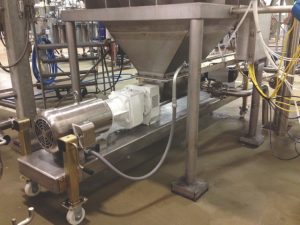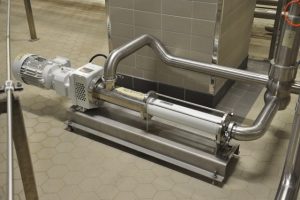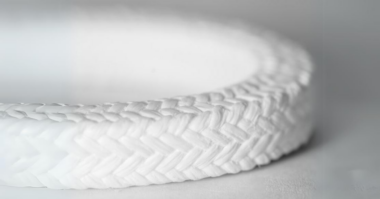By Antonio Castilhos Vice President of National Sales, NETZSCH PUMPS NORTH AMERICA
While progressing cavity pumps are not the most commonly used option for conveyance in food and beverage production, they are required for certain applications, including those requiring very gentle handling or continuous non-pulsing flow, or for conveying highly viscous media. Progressing cavity pumps can be well-suited to food and beverage applications’ essentials regarding contamination avoidance. With the right system design, progressing cavity pumps can reduce cost, lower maintenance needs, and achieve better results in complex conveying applications within food and beverage production.
Certain applications demand progressing cavity pumps
Where food and beverage pumping applications are concerned, progressing cavity pumps are rarely the first thought in system design. Rotary lobe and centrifugal pumps are far more commonly used in these applications, and indeed are often the right choice. In many situations, however, rotary lobe and centrifugal pumps are not up to the task of conveyance in food and beverage applications, or are not the most cost-effective solution.
 Progressing cavity pumps can handle higher pressures and higher viscosity materials than either rotary lobe or centrifugal pumps. Cost savings of up to 50 percent are possible with progressing cavity pumps over rotary lobe pumps, especially in smaller volume operations. The progressive cavity technology can also be designed with an open hopper that allows for the pumping of non-flowing products such as meats and vegetables. The choice in not so clear-cut for applications requiring an extremely small footprint; in these cases, designers must balance the need for the benefits achieved by use of progressing cavity pumps with available space to determine the best solution.
Progressing cavity pumps can handle higher pressures and higher viscosity materials than either rotary lobe or centrifugal pumps. Cost savings of up to 50 percent are possible with progressing cavity pumps over rotary lobe pumps, especially in smaller volume operations. The progressive cavity technology can also be designed with an open hopper that allows for the pumping of non-flowing products such as meats and vegetables. The choice in not so clear-cut for applications requiring an extremely small footprint; in these cases, designers must balance the need for the benefits achieved by use of progressing cavity pumps with available space to determine the best solution.
In the end, progressing cavity pumps are ideal for conveyance tasks in a number of food and beverage production environments, especially those with difficult-to-convey, shear-sensitive, abrasive, and/or viscous components. The pumping process in progressing cavity pumps involves a rotor turning with an eccentric rotary motion within a fixed stator. The two components are precisely geometrically mated with one another, conveying chambers are formed between them, and these chambers advance during rotation. The medium is gently transported in these chambers from the inlet to the discharge side by the turning motion. Volume and pressure remain constant with progressing cavity pump technology, regardless of the viscosity or consistency of the substance being conveyed. In addition, no shear forces, pulsation, or pressure reversal points occur, thus avoiding damage to the medium.
In food and beverage applications specifically, progressing cavity pumps must be designed to reduce the risk of contamination and help achieve the targets of the Food and Drug Administration’s (FDA’s) Food Safety Modernization Act (FSMA). To do so, pumps must use FDA- compliant materials, including metals, plastics, and elastomers, with each elastomer compound independently tested to determine suitability and be of a high hygienic design. Depending on the process and the industry, 3-A Sanitary Standards Inc. (3-A SSI) or European Hygienic Engineering and Design Group (EHEDG) certification may be required for pump systems and processes in food and beverage applications.
Making CIP work in PC/PD pumps
 CIP procedures are critically important in food and beverage conveying applications because proper pump and pipe cleaning is key to avoiding contamination, bacterial growth, and other issues. By running a cleaning agent (acids and caustics) through the pump system, proper cleaning can be ensured and regulatory requirements met. It is important therefore to utilize the cleanest possible design within the pump to minimize cleaning time and maximize production time. A well designed CIP system can even be used to CIP open hopper pumps after pumping non flowing products.
CIP procedures are critically important in food and beverage conveying applications because proper pump and pipe cleaning is key to avoiding contamination, bacterial growth, and other issues. By running a cleaning agent (acids and caustics) through the pump system, proper cleaning can be ensured and regulatory requirements met. It is important therefore to utilize the cleanest possible design within the pump to minimize cleaning time and maximize production time. A well designed CIP system can even be used to CIP open hopper pumps after pumping non flowing products.
Benefits of well-designed pumping technology
It is important to take cleaning into account when first designing the pumping system. The progressing cavity pump rotor should be designed to be compatible with both the process’s media and temperature range and the chemicals being used in the CIP process and their temperature. CIP processes can change, and when they do, compatibility with the stator elastomer should be verified and the stator or cleaning solution replaced if necessary.
Because a separate dedicated pump is used for CIP (usually a small low-cost centrifugal pump), progressing cavity pump design should include the appropriate bypass setup, to ensure that turbulent flow is achieved in both the pump and the piping downstream of the pump. The NETZSCH NEMO® Progressing Cavity Pump is a good example of this kind of design for sanitary applications. With suction and discharge ports located tangential to the body of the pump, the NEMO pumps achieve complete drainage and proper circulation through the pump for cleaning. In addition, NEMO pumps feature open hygienic joints to enable the best cleaning of the joint and the elimination of dead zones that can lead to contamination. NETZSCH with their NEMO Sanitary Plus design also offers flexible connecting rods in lieu of joints, negating any crevices and reducing CIP time even further.
A huge advantage of using a CIP pump for cleaning and a progressing cavity pump for the process is that the pump requires a much smaller motor, reducing the overall cost. In addition, the process pump never runs at high cleaning speeds, which significantly reduces maintenance and total cost of ownership.
By working with experts to assess the overall conditions of any food and beverage pumping application, by choosing the best pump for the media being conveyed, and by designing a system that allows for effective cleaning of that ideal pump, system operators can ensure sanitary processes that fit their budget, plant footprint, and regulatory requirements. The right pump design, along with fine-tuning to the final system, ensures that media is conveyed appropriately, while reducing maintenance demands and avoiding contamination.





Comments